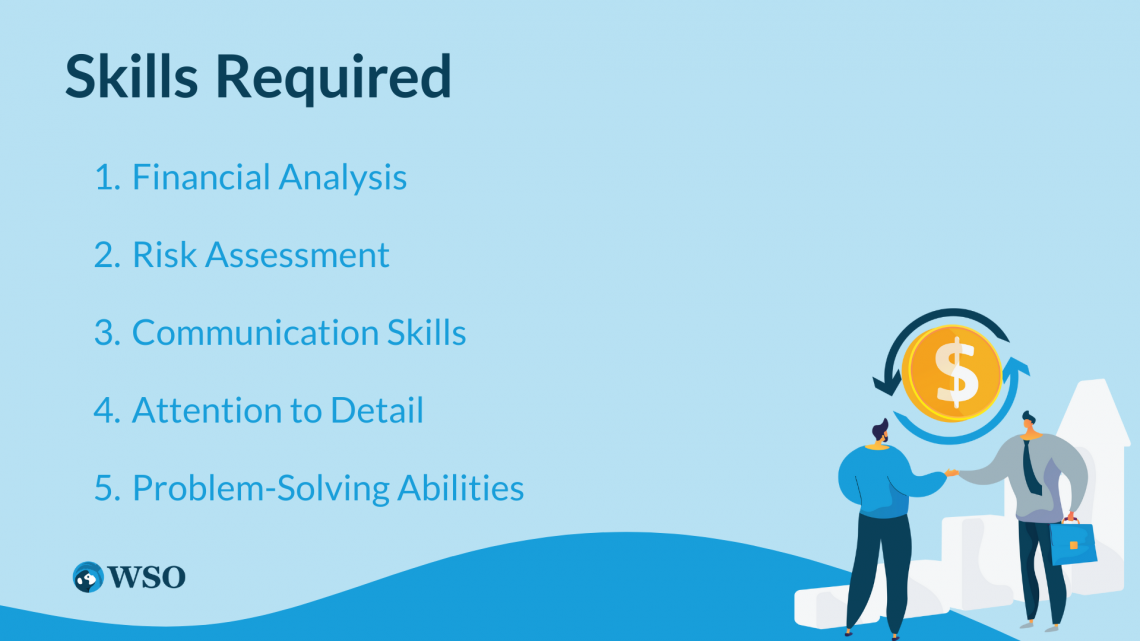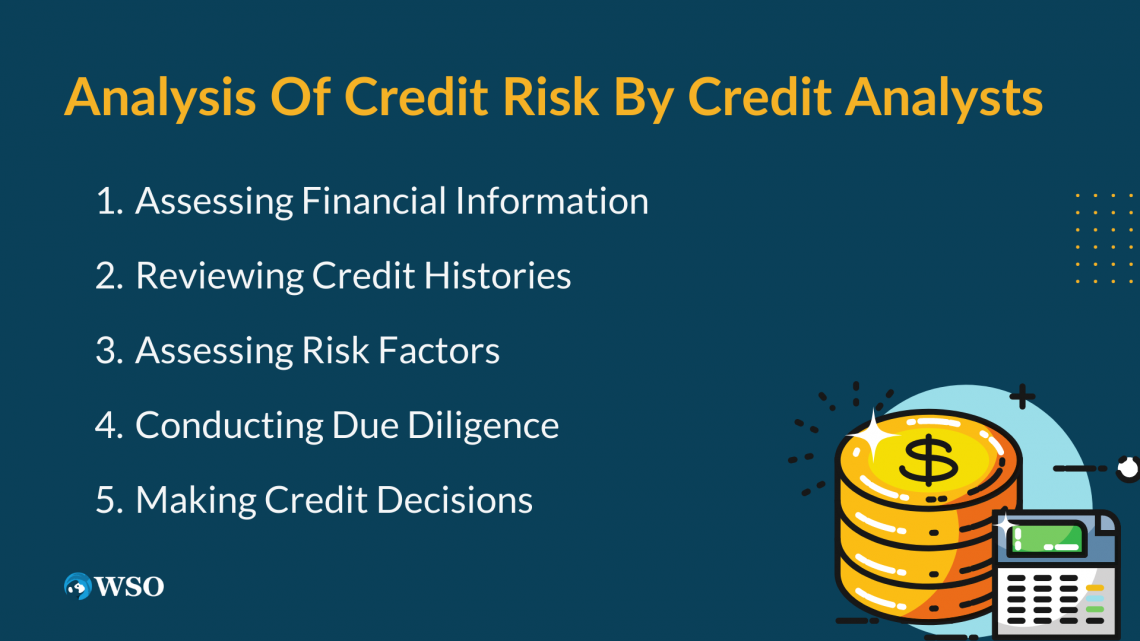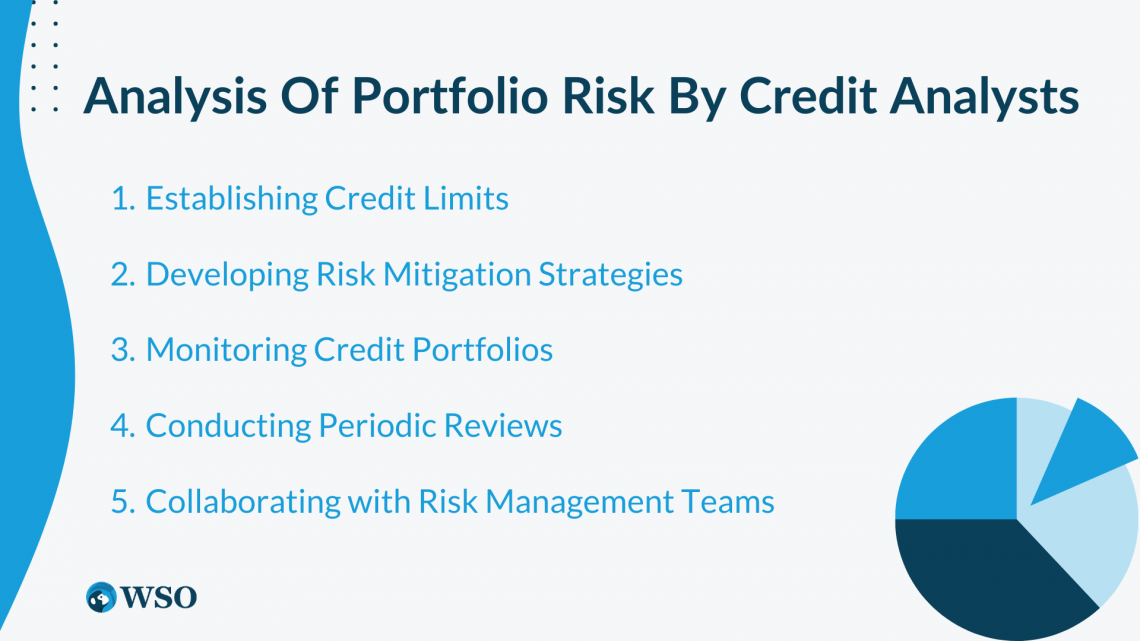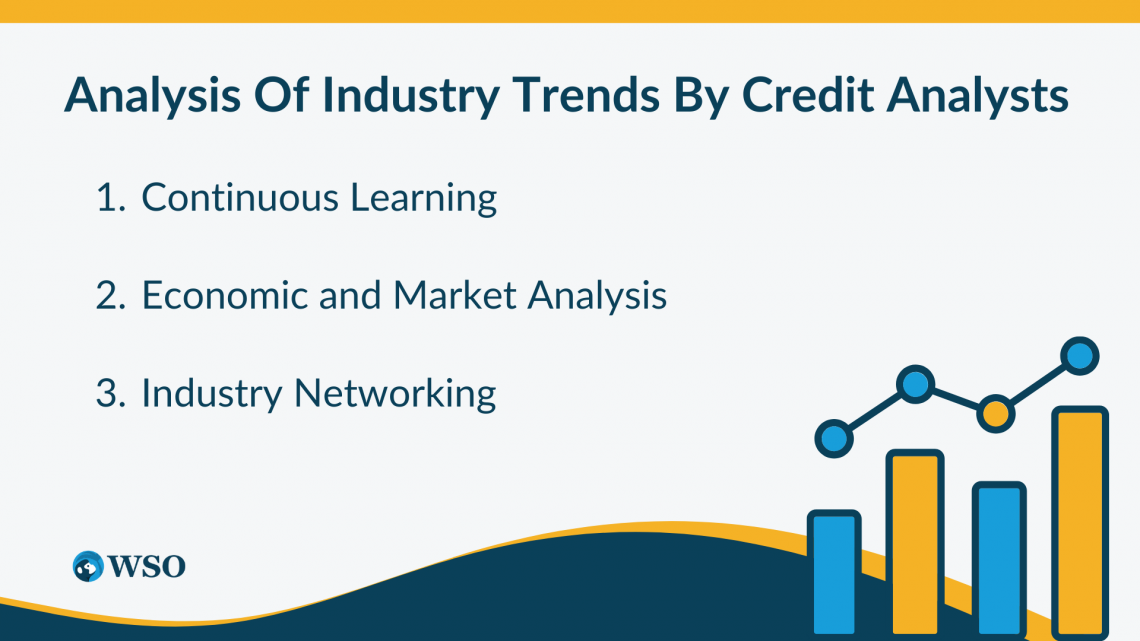Credit Analyst Description
The role of a credit analyst involves evaluating the creditworthiness of potential borrowers or investment opportunities.
When it comes to assessing the creditworthiness of individuals, companies, or investment opportunities, credit analysts hold a pivotal position within the financial industry.

At its core, the role of a credit analyst involves evaluating the creditworthiness of potential borrowers or investment opportunities.
By meticulously examining financial records, credit histories, and other relevant factors, credit analysts assess the likelihood of borrowers meeting their financial obligations.
In addition to financial analysis, credit analysts also evaluate credit histories. They review credit reports, which provide comprehensive information about an individual's or company's past credit behavior.
They keep a close eye on economic indicators, regulatory changes, and industry-specific developments that may impact the creditworthiness of borrowers or the performance of investment opportunities.
This awareness helps analysts make well-informed assessments and recommendations based on the prevailing market dynamics.

To excel in their role, credit analysts need to possess a unique set of skills. Strong analytical skills are essential to accurately evaluate financial data, identify patterns, and make sound judgments.
Effective communication skills are also vital as credit analysts often collaborate with various stakeholders, such as lenders, borrowers, and internal teams, to exchange information, validate findings, and make informed credit decisions.
Key Takeaways
- Credit analysts assess financial information, credit histories, and risk factors to determine creditworthiness.
- Analysts set appropriate credit limits, develop risk mitigation strategies, and monitor portfolios to minimize credit risks.
- Essential Skills for Credit Analysts: Strong financial analysis, risk assessment, communication, attention to detail, and problem-solving skills are essential for credit analysts.
- Analysts collaborate with relationship managers, underwriting teams, risk management departments, and credit committees to ensure comprehensive credit assessments and decision-making.
- Continuous learning, economic and market analysis, and industry networking help analysts stay informed and make informed credit decisions.
Skills Required
Credit analysts require essential skills to excel in their role. Strong financial analysis skills are crucial for evaluating creditworthiness, analyzing ratios, and assessing financial health. Risk assessment skills involve evaluating risk factors and market trends.

Effective communication skills are necessary for conveying analyses and recommendations. Attention to detail ensures accurate evaluations by meticulously reviewing documents.
1. Financial Analysis
Credit analysts must possess strong financial analysis skills to evaluate creditworthiness effectively. Proficiency in analyzing financial ratios, such as liquidity, profitability, and leverage ratios, is essential.
NOTE
By conducting thorough financial analysis, analysts can assess the financial health of borrowers, identify potential risks, and make informed credit decisions.
2. Risk Assessment
The ability to identify and assess risks is a critical skill for analysts. They must have a keen eye for evaluating risk factors associated with borrowers, industries, and economic conditions.
This involves analyzing market trends, industry dynamics, and macroeconomic factors that may impact borrowers' creditworthiness.
NOTE
By conducting comprehensive risk assessments, analysts can accurately evaluate the likelihood of default and make informed judgments about extending credit.
3. Communication Skills
Effective communication is vital for credit analysts as they need to convey their analysis and recommendations to various stakeholders, including loan officers, senior management, and clients.
Analysts should be able to articulate complex financial information clearly and concisely. Strong written and verbal communication skills are essential to preparing comprehensive credit reports, presenting findings, and providing recommendations.
NOTE
Clear communication ensures that all stakeholders understand the credit analysis and can make informed decisions.
4. Attention to Detail
Credit analysts must possess a high level of attention to detail to accurately evaluate creditworthiness. They meticulously review financial documents, credit histories, loan applications, and other relevant information to gather all the necessary data for analysis.
Attention to detail helps analysts identify potential red flags, inconsistencies, or discrepancies that may impact credit decisions.
NOTE
By carefully examining the details, analysts can ensure the accuracy and reliability of their assessments.
5. Problem-Solving Abilities
Credit analysts should possess strong problem-solving skills to navigate complex credit situations. They encounter diverse credit scenarios and must be able to analyze information, identify patterns, and develop creative solutions.
This may involve evaluating alternative financing structures, proposing risk mitigation strategies, or recommending adjustments to credit terms.
NOTE
By applying their problem-solving abilities, analysts can address challenges, mitigate risks, and find optimal solutions that balance the needs of the borrower and the lender.
These skills enable analysts to conduct thorough evaluations, make informed credit decisions, and contribute to the overall risk management of financial institutions. Analysts can excel in their roles by continuously honing these skills and supporting responsible lending practices.
Analysis of Credit Risk by Credit Analysts
Evaluating creditworthiness involves meticulously assessing financial information, credit histories, and risk factors and conducting due diligence.

Credit analysts analyze the three financial statements, including revenue trends, profitability ratios, and debt levels, to comprehensively understand an individual or entity's financial health.
1. Assessing Financial Information
Credit analysts meticulously evaluate the three financial statements to comprehensively understand an individual's or entity's financial health.
They analyze metrics that typically include revenue trends, profitability ratios, and debt levels to assess the ability to meet financial obligations.
2. Reviewing Credit Histories
Analysts delve into credit reports and payment histories to gather crucial information about an applicant's credit behavior and repayment patterns.
A history of timely payments and responsible credit management is a positive indicator. In contrast, a pattern of late payments or defaults may raise concerns about the applicant's ability to honor financial commitments.
3. Assessing Risk Factors
Analysts consider a range of risk factors when evaluating credit applications. They assess industry trends, economic conditions, competitive landscapes, and regulatory environments to understand the potential risks associated with extending credit.
NOTE
Analysts gain insights into external factors that may impact an applicant's ability to repay debts by analyzing market data, industry reports, economic indicators, and relevant news. This comprehensive assessment allows them to make informed credit decisions and set appropriate terms and conditions.
4. Conducting Due Diligence
In addition to analyzing financial information and credit histories, analysts conduct thorough due diligence to uncover any additional risks.
This involves verifying the accuracy of the provided information, conducting background checks, and assessing the applicant's reputation and integrity.
Thorough due diligence will ensure the accuracy and reliability of the information. This will enable them to make well-informed decisions and minimize possible instances of fraud.
5. Making Credit Decisions
Based on their evaluation of financial information, credit histories, risk factors, and due diligence, analysts make credit decisions.
They determine the creditworthiness of applicants, recommend appropriate credit limits, interest rates, and repayment terms, and assess the overall risk associated with extending credit.
NOTE
The Analyst’s objective is to strike a balance between mitigating risk and supporting responsible lending to promote financial stability for both the lender and the borrower.
Their expertise in assessing creditworthiness helps financial institutions make informed decisions, manage risks effectively, and maintain a healthy credit portfolio.
Analysis of Portfolio Risk by Credit Analysts
Credit analysts mitigate credit risks by establishing appropriate credit limits based on comprehensive assessments of borrowers' creditworthiness, income levels, and risk appetite.

They develop risk mitigation strategies such as collateral requirements and repayment structures. Additional responsibilities include monitoring credit portfolios, tracking payment patterns, and identifying potential risks or delinquencies.
1. Establishing Credit Limits
Credit analysts play a crucial role in determining appropriate credit limits for borrowers.
Based on their comprehensive assessment of various metrics, they can determine credit limits that match the borrower’s ability to pay. Such factors include the borrower's creditworthiness, income levels, and the organization's risk appetite.
By setting appropriate credit limits, analysts aim to minimize the risk of default and ensure that the borrower can comfortably meet their financial obligations.
2. Developing Risk Mitigation Strategies
Analysts are responsible for developing effective strategies to mitigate credit risks. They assess specific risk factors associated with each credit application and may recommend various risk mitigation measures.
These measures typically include a need for collateral or security for the credit. They also include imposing loan conditions that outline specific conditions or restrictions, or even suggesting repayment structures that align with the borrower's cash flow.
NOTE
By implementing these strategies, analysts aim to reduce the risk of non-payment or default and protect the lender's interests.
3. Monitoring Credit Portfolios
Credit analysts monitor credit portfolios and identify potential risks or delinquencies.
They regularly review the performance of existing credit accounts, track payment patterns, analyze credit utilization rates, and assess changing circumstances that may impact the borrower's ability to repay.
By closely monitoring credit portfolios, analysts can proactively identify and address any emerging credit risks, take appropriate actions to mitigate potential losses, and ensure the borrowers' continued creditworthiness.
4. Conducting Periodic Reviews
In addition to continuous monitoring, credit analysts periodically review credit portfolios. These reviews involve reassessing borrowers' creditworthiness, reviewing their financial positions, and evaluating any changes in their risk profiles.
By conducting these reviews, analysts can identify any deteriorating credit conditions, make adjustments to credit limits or terms if necessary, and take timely action to minimize potential losses.
NOTE
These reviews also provide an opportunity to identify opportunities for credit limit increases or other credit enhancements for borrowers who have demonstrated improved creditworthiness over time.
5. Collaborating with Risk Management Teams
Credit analysts work closely with risk management teams within financial institutions to ensure a comprehensive approach to mitigating credit risks.
They collaborate with risk managers to align credit risk strategies, share insights on emerging risks, and contribute to developing and implementing credit risk management policies and procedures.
Analysts play a vital role in mitigating credit risks by establishing appropriate credit limits, developing risk mitigation strategies, monitoring credit portfolios, conducting periodic reviews, and collaborating with risk management teams.
Their expertise in assessing and managing credit risks helps financial institutions maintain a healthy credit portfolio, protect against potential losses, and support responsible lending practices.
Analysis of Industry Trends by Credit Analysts
Credit analysts prioritize continuous learning to stay updated on industry trends. They also conduct economic and market analyses to assess the impact on creditworthiness.

Active industry networking allows them to exchange insights and best practices, further improving their credit assessments and risk management capabilities.
By staying informed, analysts make accurate credit decisions, identify risks, and contribute to financial stability while fostering strong relationships with borrowers.
1. Continuous Learning
Credit analysts understand the importance of continuous learning and professional development. They actively seek opportunities to enhance their knowledge and stay informed about evolving industry trends, regulatory changes, and emerging risk factors.
Analysts attend industry conferences, participate in training programs, and engage in workshops and seminars to stay updated on best practices and the latest developments in credit analysis.
By continuously expanding their knowledge base, analysts ensure their credit assessments are based on the most up-to-date information and industry standards.
2. Economic and Market Analysis
Credit analysts recognize the significance of monitoring economic indicators, market conditions, and industry-specific developments.
NOTE
The Analysts conduct thorough research, analyze market reports, and stay updated on economic news to assess the potential impact on borrowers' creditworthiness and the overall credit environment.
By closely monitoring economic trends, analysts can identify potential risks, such as changes in interest rates, shifts in consumer behavior, or industry disruptions, which may affect the borrowers' creditworthiness.
This proactive approach enables them to make informed credit decisions and implement risk mitigation strategies accordingly.
3. Industry Networking
Credit analysts actively engage in industry networking to exchange knowledge, insights, and best practices with their peers.
They participate in professional associations, join analyst forums, and connect with industry experts to stay connected with the latest trends and developments.
NOTE
By building a strong professional network, analysts have access to valuable resources and information that can inform their credit assessments and enhance their risk management capabilities.
By collaborating with stakeholders and staying updated on industry trends, analysts can make accurate credit assessments, identify potential risks, and mitigate them effectively.
Their expertise in evaluating creditworthiness and managing risks contributes to organizations' overall financial health and stability, ensuring prudent lending practices and fostering long-term relationships with borrowers.
Credit Analysts and Stakeholders
Credit analysts collaborate with various stakeholders throughout the credit evaluation process. They work closely with relationship managers to gather information about borrowers and provide insights for structuring appropriate credit solutions.

Collaboration with underwriting teams ensures holistic risk assessment and determination of credit terms.
1. Working with Relationship Managers
Credit analysts collaborate closely with relationship managers or loan officers throughout the credit evaluation process. They work together to gather information about borrowers, understand their specific credit needs, and assess their creditworthiness.
Analysts provide valuable insights and recommendations to help relationship managers structure appropriate credit solutions that meet the borrower's requirements while aligning with the institution's risk appetite.
NOTE
This collaborative partnership ensures that the credit analysis is comprehensive and considers both the financial aspects and the client's specific circumstances.
2. Partnering with the Underwriting Teams
In large financial institutions, analysts often work in collaboration with underwriting teams. Underwriters have expertise in evaluating and managing risk, and they assess the overall creditworthiness of borrowers.
Analysts share their credit assessments and collaborate with underwriters to determine credit facility terms, conditions, and pricing.
This collaborative approach ensures that credit decisions are based on a holistic evaluation of risk factors and are aligned with the institution's underwriting guidelines and credit policies.
NOTE
By working together, analysts and underwriters can ensure consistent credit decision-making and enhance the overall quality of the loan portfolio.
3. Engaging with Risk Management Departments
Credit analysts also collaborate with risk management departments within financial institutions. They provide insights and data to support the development of credit risk management strategies and policies.
NOTE
Analysts contribute to the institution's overall risk assessment and mitigation efforts by sharing credit analysis findings and observations.
This collaboration helps ensure credit risks are appropriately identified, measured, and monitored.
4. Liaising with the Credit Committees
Credit analysts participate in credit committees or credit review meetings in some organizations.
They present their credit analysis and recommendations to senior management or credit committees, providing a comprehensive overview of the borrower's creditworthiness and the associated risks.
This collaborative interaction allows for discussions, debates, and collective decision-making to ensure that credit decisions align with the institution's risk appetite and overall business objectives.
NOTE
Analysts can leverage collective expertise, knowledge, and insights by collaborating with stakeholders such as relationship managers, underwriting teams, risk management departments, and credit committees.
This collaboration enhances credit assessments, ensures consistency in decision-making, and supports responsible lending practices within financial institutions.
Conclusion
Credit analysts play a crucial role in the financial ecosystem by evaluating creditworthiness and mitigating risks. Their expertise and meticulous analysis enable them to provide valuable insights to lenders, investors, and financial institutions.

In addition to financial analysis, credit analysts delve into credit histories and payment patterns to gather crucial information about an applicant's credit behavior.
A history of responsible credit management and timely payments is viewed positively, while a pattern of late payments or defaults raises concerns about their ability to honor financial commitments.
Credit analysts conduct thorough due diligence to ensure accuracy and reliability by verifying the provided information, conducting background checks, and assessing the applicant's reputation and integrity.
This helps identify any additional risks and minimizes instances of fraud.
Based on their evaluation of financial information, credit histories, risk factors, and due diligence, analysts make credit decisions.

They determine the creditworthiness of applicants, recommend appropriate credit limits, interest rates, and repayment terms, and assess the overall risk associated with extending credit.
Their objective is to strike a balance between mitigating risk and supporting responsible lending practices to promote financial stability.
In summary, credit analysts are instrumental in evaluating creditworthiness and mitigating risks for individuals, companies, and investment opportunities.









or Want to Sign up with your social account?